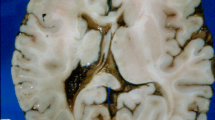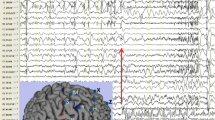Abstract
Focal cortical dysplasias (FCD) are frequent findings in therapy–refractory epilepsies of childhood. Variable clinical histories, as well as the spectrum of neuroradiological and histopathological findings render an internationally approved classification system difficult to obtain. This review summarizes major neuropathological features of FCD and discusses two recently published classification scales, i.e. from Palmini and Lüders and that established by Spreafico and Avanzini. Both systems rely on histopathological findings and separate two groups of patients: 1) focal cortical dysplasias with architectural abnormalities of cortical structure and ectopic neurons in the white matter and 2) cytoarchitectural abnormalities including dysplastic neurons and balloon cells. To elucidate pathogenic mechanisms of these complex malformations will be a major challenge for the future. The newly introduced neuropathological reference center for epilepsy surgery (www.epilepsie-register.de) may be a helpful tool for such clinicopathological research strategies.
Zusammenfassung
Fokale kortikale Dysplasien (FCD) stellen einen häufigen Befund bei therapierefraktären Epilepsien des Kindesalters dar. Klinik, Bildgebung und der histopathologische Befund variieren erheblich, sodass sich bislang noch kein international verbindliches Klassifikationssystem etablieren konnte. Im Folgenden werden die charakteristischen neuropathologischen Befunde bei FCD und die zwei gebräuchlichsten Klassifikationssysteme vorgestellt: Die Klassifikation der internationalen Liga gegen Epilepsie nach Palmini und Lüders sowie die Klassifikation der Mailänder Arbeitsgruppe von Spreafico und Avanzini. Beide Klassifikationsschemata unterscheiden im Wesentlichen zwei Gruppen: 1. Die Gruppe der FCD mit Störungen der kortikalen Architektur und ektopen Nervenzellen in der weißen Substanz und 2. die Gruppe mit zellulären Auffälligkeiten im Sinne von dysplastischen Nervenzellen und Ballonzellen. Weitere fakultative Befunde wie persistierende Neurone in Lamina I oder perivaskuläre Oligodendrozytencluster werden kontrovers diskutiert. Deshalb ist es umso wichtiger, für zukünftige Studien auch molekulargenetische Untersuchungen mit einzubeziehen, um Hinweise für die zu Grunde liegenden Pathomechanismen zu erhalten. Für diese Studie sind umfassende Gewebesammlungen sowie klinische Parameter zwingend erforderlich, wie sie derzeit durch das neuropathologische Epilepsieregister (www.epilepsie-register.de) erarbeitet werden.
Similar content being viewed by others
References
Kuzniecky RI, Barkovich AJ (2001) Malformations of cortical development and epilepsy. Brain Dev 23(1):2–11
Urbach H, Scheffler B, Heinrichsmeier T, von Oertzen J, Kral T,Wellmer J et al. (2002) Focal cortical dysplasia of Taylor’s balloon cell type: a clinicopathological entity with characteristic neuroimaging and histopathological features, and favorable postsurgical outcome. Epilepsia 43(1):33–40
Mischel PS, Nguyen LP, Vinters HV (1995) Cerebral cortical dysplasia associated with pediatric epilepsy. Review of neuropathologic features and proposal for a grading system. J Neuropathol Exp Neurol 54(2):137–153
Palmini A, Lüders HO (2002) Classification issues in malformations caused by abnormalities of cortical development. Neurosurg Clin N Am 13(1):1–16
Tassi L, Colombo N, Garbelli R, Francione S, Lo Russo G, Mai R et al. (2002) Focal cortical dysplasia: neuropathological subtypes, EEG, neuroimaging and surgical outcome. Brain 125(Pt 8):1719–1732
Thom M, Harding BN, Lin WR, Martinian L, Cross H, Sisodiya SM (2003) Cajal-Retzius cells, inhibitory interneuronal populations and neuropeptide Y expression in focal cortical dysplasia and microdysgenesis. Acta Neuropathol (Berl) 105(6):561–569
Meencke HJ, Janz D (1984) Neuropathological findings in primary generalized epilepsy: a study of eight cases. Epilepsia 25(1):8–21
Lahl R, Villagran R, Teixeira W (2003) Malformations of cortical development. In: Neuropathology of focal epilepsies. An Atlas. John Libbey, Bielefeld, Eastleigh, p 96–134
Kasper BS, Stefan H, Paulus W (2003) Microdysgenesis in mesial temporal lobe epilepsy: a clinicopathological study. Ann Neurol 54(4):501–506
Rojiani AM, Emery JA, Anderson KJ, Massey JK (1996) Distribution of heterotopic neurons in normal hemispheric white matter: a morphometric analysis. J Neuropathol Exp Neurol 55(2):178–183
Fauser S, Becker A, Schulze-Bonhage A, Hildebrandt M, Tuxhorn I, Lahl R et al. (2003) The stem cell epitope CD34 is abundantly expressed in focal cortical dysplasias of Taylor’s balloon cell type (in press)
Thom M, Holton JL, D’Arrigo C, Griffin B, Beckett A, Sisodiya S et al. (2000) Microdysgenesis with abnormal cortical myelinated fibres in temporal lobe epilepsy: a histopathological study with calbindin D-28-K immunohistochemistry. Neuropathol Appl Neurobiol 26(3):251–257
Komori T, Arai N, Shimizu H, Yagishita A, Mizutani T, Oda M (2002) Cortical perivascular satellitosis in intractable epilepsy; a form of cortical dysplasia? Acta Neuropathol (Berl) 104(2):149–154
Seifert G, Hüttmann K, Steinhäuser C (2003) Seizure-related changes of astrocytes in the hippocampus of epilepsy patients. Z Epileptol 16(1):250–256
Tassi L, Colombo N, Garbelli R, Fracione S, Lo Russo G, Mai R, Cardinale F, Cossu M, Ferrario A, Galli C, Bramerio M, Citterio A, Spreafico R (2002) Focal cortical dysplasia: neuropathological subtypes, EEG, neuroimaging and surgical outcome. Brain 125(Pt 8):17198–1732
Taylor DC, Falconer MA, Bruton CJ, Corsellis JA (1971) Focal dysplasia of the cerebral cortex in epilepsy. J Neurol Neurosurg Psychiatry 34(4):369–387
Becker AJ, Urbach H, Scheffler B, Baden T, Normann S, Lahl R et al. (2002) Focal cortical dysplasia of Taylor’s balloon cell type: mutational analysis of the TSC1 gene indicates a pathogenic relationship to tuberous sclerosis. Ann Neurol 52(1):29–37
Author information
Authors and Affiliations
Corresponding author
Rights and permissions
About this article
Cite this article
Hildebrandt, M., Blümcke, I. Fokale kortikale Dysplasien des Menschen . Z Epileptol 17, 209–214 (2004). https://doi.org/10.1007/s10309-004-0071-7
Received:
Accepted:
Published:
Issue Date:
DOI: https://doi.org/10.1007/s10309-004-0071-7




